第六章 蒸汽动力装置
- 格式:doc
- 大小:4.50 MB
- 文档页数:3
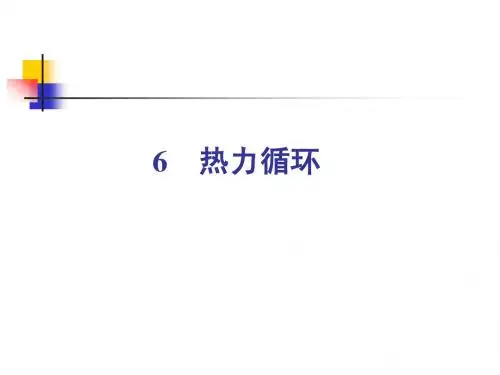
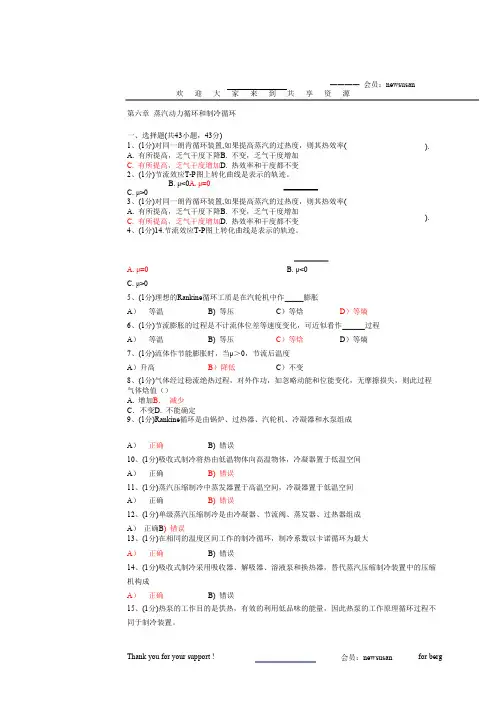
欢迎大家来到共享资源第六章 蒸汽动力循环和制冷循环―――― 会员:newsusan 一、选择题(共43小题,43分)1、(1分)对同一朗肯循环装置,如果提高蒸汽的过热度,则其热效率( A. 有所提高,乏气干度下降B. 不变,乏气干度增加 C. 有所提高,乏气干度增加D. 热效率和干度都不变2、(1分)节流效应T-P 图上转化曲线是表示的轨迹。
B. μ<0A. μ=0 C. μ>03、(1分)对同一朗肯循环装置,如果提高蒸汽的过热度,则其热效率( A. 有所提高,乏气干度下降B. 不变,乏气干度增加 C. 有所提高,乏气干度增加D. 热效率和干度都不变4、(1分)14.节流效应T-P 图上转化曲线是表示的轨迹。
A. μ=0 C. μ>05、(1分)理想的Rankine 循环工质是在汽轮机中作_____膨胀 A ) A ) 等温 等温 B) 等压 B) 等压 B )降低C )等焓 C )等焓 C )不变D )等熵 D )等熵6、(1分)节流膨胀的过程是不计流体位差等速度变化,可近似看作______过程7、(1分)流体作节能膨胀时,当μ>0,节流后温度A )升高B. μ<0).).8、(1分)气体经过稳流绝热过程,对外作功,如忽略动能和位能变化,无摩擦损失,则此过程 气体焓值() A. 增加B . 减少 C .不变D. 不能确定9、(1分)Rankine 循环是由锅炉、过热器、汽轮机、冷凝器和水泵组成 A ) A ) A ) 正确 正确 正确B) 错误 B) 错误 B) 错误10、(1分)吸收式制冷将热由低温物体向高温物体,冷凝器置于低温空间 11、(1分)蒸汽压缩制冷中蒸发器置于高温空间,冷凝器置于低温空间 12、(1分)单级蒸汽压缩制冷是由冷凝器、节流阀、蒸发器、过热器组成 A ) 正确B ) 错误13、(1分)在相同的温度区间工作的制冷循环,制冷系数以卡诺循环为最大 A ) 正确 B) 错误14、(1分)吸收式制冷采用吸收器、解吸器、溶液泵和换热器,替代蒸汽压缩制冷装置中的压缩机构成 A ) 正确 B) 错误15、(1分)热泵的工作目的是供热,有效的利用低品味的能量,因此热泵的工作原理循环过程不同于制冷装置。
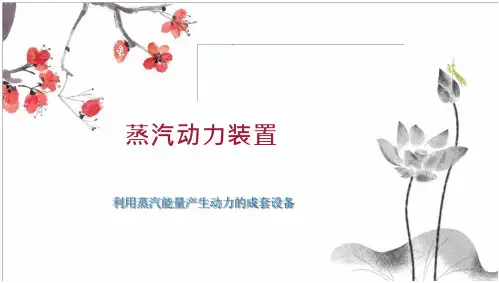
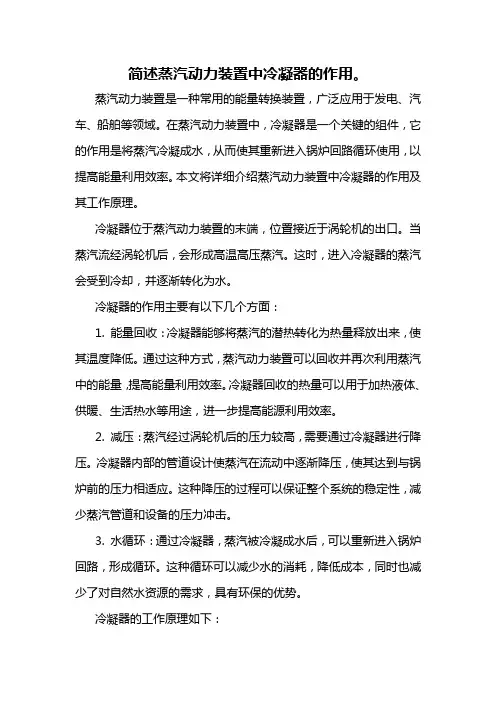
简述蒸汽动力装置中冷凝器的作用。
蒸汽动力装置是一种常用的能量转换装置,广泛应用于发电、汽车、船舶等领域。
在蒸汽动力装置中,冷凝器是一个关键的组件,它的作用是将蒸汽冷凝成水,从而使其重新进入锅炉回路循环使用,以提高能量利用效率。
本文将详细介绍蒸汽动力装置中冷凝器的作用及其工作原理。
冷凝器位于蒸汽动力装置的末端,位置接近于涡轮机的出口。
当蒸汽流经涡轮机后,会形成高温高压蒸汽。
这时,进入冷凝器的蒸汽会受到冷却,并逐渐转化为水。
冷凝器的作用主要有以下几个方面:1. 能量回收:冷凝器能够将蒸汽的潜热转化为热量释放出来,使其温度降低。
通过这种方式,蒸汽动力装置可以回收并再次利用蒸汽中的能量,提高能量利用效率。
冷凝器回收的热量可以用于加热液体、供暖、生活热水等用途,进一步提高能源利用效率。
2. 减压:蒸汽经过涡轮机后的压力较高,需要通过冷凝器进行降压。
冷凝器内部的管道设计使蒸汽在流动中逐渐降压,使其达到与锅炉前的压力相适应。
这种降压的过程可以保证整个系统的稳定性,减少蒸汽管道和设备的压力冲击。
3. 水循环:通过冷凝器,蒸汽被冷凝成水后,可以重新进入锅炉回路,形成循环。
这种循环可以减少水的消耗,降低成本,同时也减少了对自然水资源的需求,具有环保的优势。
冷凝器的工作原理如下:蒸汽在进入冷凝器后,首先与冷却介质(通常为冷水或冷却塔冷却水)进行热量传递,蒸汽的温度逐渐降低。
热量传递的方式通常是通过冷凝器内外表面的热传导,也可以通过喷淋装置将冷却介质喷洒到冷凝器内部,使蒸汽与冷却介质之间充分接触。
冷凝器内部通常有大量的管道,用于增加热交换面积,提高热传导效率。
此外,冷凝器内部还设置有冷凝器表面使水蒸气通过冷凝器内部的管道流动时不会形成干度过高,影响热量传递的阻塞物。
冷却介质在与蒸汽进行热量交换后,会被加热,形成热水或蒸气。
这些热水或蒸气可以再次利用,例如用于供暖或发电。
最后,蒸汽在冷凝器内部的热量传递过程中,逐渐冷凝成水。

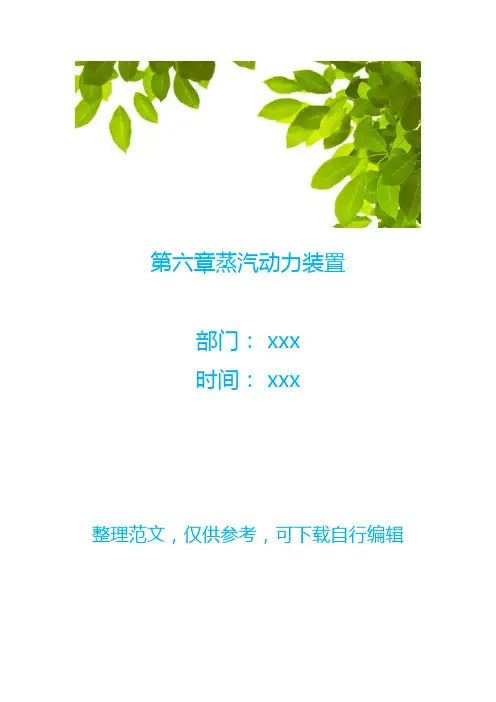
第六章蒸汽动力装置部门: xxx时间: xxx整理范文,仅供参考,可下载自行编辑第六章 动力装置循环英文习题1. Power generation by a steamturbineThe power output of an adiabaticsteam turbine is 5MW, and the inlet and the exit conditions of the steam are as indicated in Fig.6-1.(a> Compare t he magnitudes of Δh, Δke, Δpe.(b> Determine the work done per unit mass of the steam flowing through the turbine. (c> Calculate the mass flow rate of the steam.b5E2RGbCAP 2. The simple ideal Rankine cycleConsider a steam power plant operating on the simple ideal Rankine cycle. The steam enters the turbine at 3 MPa and 350℃ and is condensed in the condenser at a pressure of 75 kPa. Determine the thermal efficiency of this cycle.p1EanqFDPw3. Effect ofboilerpressure andtemperatureonefficiencyDXDiTa9E3dFIGURE 6-1FIGURE 6-2Consider asteam powerplantoperatingon the ideal Rankine cycle. The steam enters the turbine at 3 MPa and 350℃ and is condensed in the condenser at a pressure of 10 kPa. Determine (a> the thermal efficiency of this power plant, (b> the thermal effic iency if the steam is superheated to 600℃ instead of 350℃, and (c> the thermal efficiency if the boiler pressure is raised to 15 MPa while the turbine inlet temperature is maintained at 600℃.RTCrpUDGiT 4. The ideal reheat Rankine cycleConsider a steam power plant operating on the ideal reheat Rankine cycle. Steam enters the high-pressure turbine at 15 MPa and 600℃ and is condensed in the condenser at a pressure of 10 kPa. If the moisture content of the steam at the exit of the low-pressure turbine is not to exceed 10.4 percent, determine (a> the pressure at which the steam should be reheated and (b> the thermal efficiency of the cycle. Assume the steamisFIGURE 6-3reheated to the inlet temperature of the high-pressure turbine.5PCzVD7HxA5. The idealregenerative Rankine cycleConsider a steam power plant operating on the ideal regenerative Rankine cycle with one open feedwater heater. Steam enters the turbine at 15 MPa and 600℃ and is condensed in the condenser at a pressure of 10 kPa. Some steam leaves the turbine at a pressure of 1.2 MPa and enters the open feedwater heater. Determine the fraction of steam extracted from the turbine and the thermal efficiency of the cycle.jLBHrnAILg工程热力学与传热学 第六章动力装置循环习题1. 试画出简单蒸汽动力装置的系统图,简单蒸汽动力装置循环的p-v 图与T-s 图。
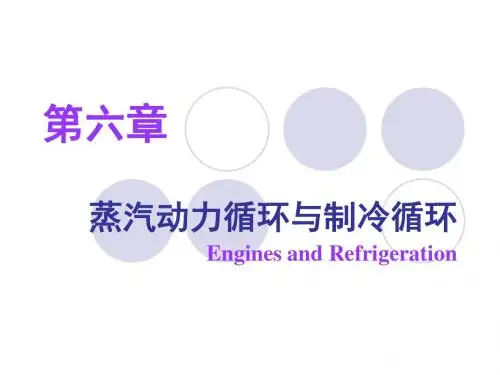
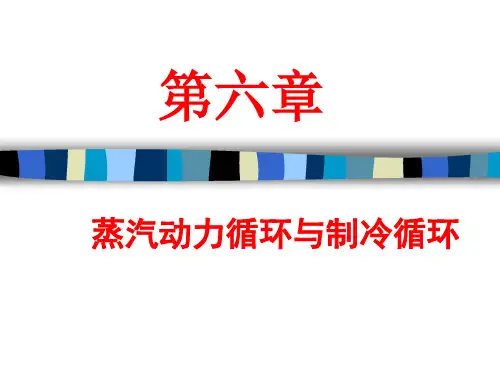
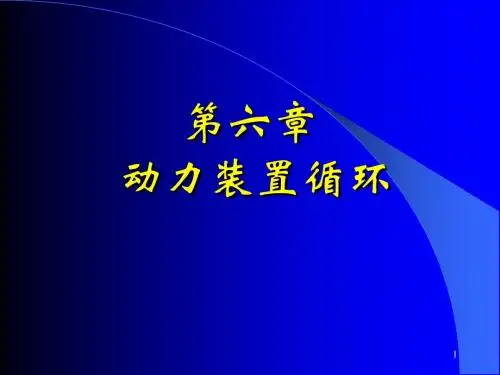

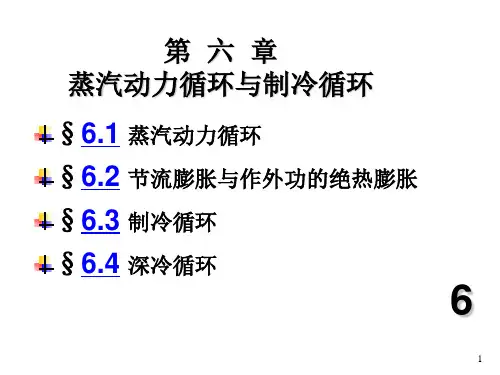
蒸汽动力装置蒸汽动力装置自英国首次将使用汽轮机的蒸汽动力装置用于“透平尼亚”(Turbinia)号船以来,使用汽轮机的蒸汽动力装置已有近百年的历史。
它曾经统治大功率舰船推进装置领域近半个世纪。
20世纪60年代以来,随着航空发动机改装为舰用燃气轮机的成功,苏、美相继于1962年和1975年分别建成了第一艘全部采用燃气轮机的军舰。
英国在1968年宣布了在护卫舰以上的大吨位军舰上全部采用燃气轮机的政策。
加拿大海军也有类似的政策声明。
但事实上,采用蒸汽动力装置推进的舰艇仍然是各国海军的主要力量之一。
舰用蒸汽动力装置在这些挑战中仍在不断地完善自己,并有了新的发展。
因此,舰用蒸汽动力装置在作为主要的舰艇动力上仍然有着不可取代的历史地位。
无论在大吨位的航空母舰上,还是在采用压水堆的核动力潜艇上至今仍是唯一可用的不可取代的动力装置。
因为前者需要较大的单机功率,使其他的动力装置不能与之攀比。
后者的二回路实际上就是蒸汽循环。
舰用蒸汽动力装置自20世纪60年代以来发展得比较稳定,技术相当成熟,达到了很高的水平。
目前的发展特点如下:1.功率有所增大战前护卫舰蒸汽轮机,单机功率一般仅4410kW(6000bp),美海军在20世纪40年代末服役的“基林”级驱逐舰,单机功率22050kW(30000hp)。
60年代服役的“薛尔曼”级驱逐舰和“布鲁克”和“诺克斯”级护卫舰,单机功率25725kW(35000hp)。
60年代服役的“孔兹”级驱逐舰的蒸汽动力装置,单机功率31237.5kW(42500hp),并作为标准动力装置使用。
目前美海军最大的蒸汽动力装置用在航空母舰上,最大单机功率51450kW(70000hp)。
前苏联为了满足各类舰艇对功率的要求,研制了功率不等的各种型号的机组,如TB-9功率为7350kW(10000hp);TB-8为26460kW(36000hp);TB-12为33075kW(45000hp)。
而单机功率最大的是TB-4为51450kW(70000hp)。
第六章 动力装置循环
英文习题
1. Power generation by a steam turbine
The power output of an adiabatic steam turbine is 5MW, and the
inlet and the exit conditions of the steam are as indicated in
Fig.6-1. (a) Compare the magnitudes of Δh, Δke, Δpe. (b) Determine the work done per unit mass of the steam flowing through the turbine. (c) Calculate the mass flow rate of the
steam.
2. The simple ideal Rankine cycle
Consider a steam power plant operating on the simple
ideal
Rankine cycle. The steam enters the turbine at 3 MPa and 350℃ and is condensed in the condenser at a pressure of 75 kPa. Determine the thermal efficiency of this cycle.
3. Effect of boiler pressure and temperature on efficiency
Consider a steam
power plant operating on the ideal Rankine cycle. The steam enters the turbine at 3 MPa and 350℃ and is condensed in the condenser at a pressure of 10 kPa. Determine (a) the thermal efficiency of this power plant, (b) the thermal efficiency if the steam is superheated to 600℃ instead of 350℃, and (c) the thermal efficiency if the boiler pressure is raised to 15 MPa while the turbine inlet temperature is maintained at 600℃
.
FIGURE 6-1
FIGURE 6-2
FIGURE 6-3
4. The ideal reheat Rankine cycle
Consider a steam power plant operating on the ideal reheat Rankine cycle. Steam enters the high-pressure turbine at 15 MPa and 600℃ and is condensed in the condenser at a pressure of 10 kPa. If the moisture content of the steam at the exit of the low-pressure turbine is not to exceed 10.4 percent, determine (a) the pressure at which the steam should be reheated and (b) the thermal efficiency of the cycle. Assume the steam is reheated to the inlet temperature of the high-pressure turbine.
5. The ideal regenerative Rankine cycle
Consider a steam power plant operating on the ideal regenerative Rankine cycle with one open feedwater heater. Steam enters the turbine at 15 MPa and 600℃ and is condensed in the condenser at a pressure of 10 kPa. Some steam leaves the turbine at a pressure of 1.2 MPa and enters the open feedwater heater. Determine the fraction of steam extracted from the turbine and the thermal efficiency of the cycle.
工程热力学与传热学
第六章 动力装置循环 习题
1. 试画出简单蒸汽动力装置的系统图,简单蒸汽动力装置循环的p-v 图与T-s 图。
2.
既然利用抽气回热可以提高蒸汽动力装置循环的热效率,能否将全部蒸汽抽出来用于回热?为
习 题
FIGURE 6-4
FIGURE 6-5
什么回热能提高热效率?
3.蒸汽动力装置循环热效率不高的原因是冷凝器放热损失太大,如取消冷凝器而用压缩机将乏汽直接升压送回锅炉是否可以?
4.卡诺循环优于相同温度范围的其它循环,为什么蒸汽动力循环不采用卡诺循环?
5.某朗肯循环,新蒸汽的参数为p1=4MPa,t1=400℃,乏汽的压力p2=4kPa,忽略泵功,试计算此循环的循环净功,加热量,热效率及乏汽的干度x。
若t1=550,p1和p2不变,以上各量为多少?
6.某船用理想蒸汽动力装置,汽轮机入口新蒸汽的参数为p1=6MPa,t1=560℃,冷凝器内蒸汽压力为6 kPa,忽略泵功,试求循环热效率。
若该装置的功率为10MW,试求每小时耗气量。
习题解答
1.答:简单蒸汽动力装置的系统组成锅炉,汽轮机,冷凝器,给水泵。
2.答:不能,还要保证部分蒸汽在汽轮机中继续膨胀对外作功。
回热提高了给水温度,相应地提高了吸热平均温度,从而提高了蒸汽动力装置的热效率。
3.答:不可以。
根据热力学第二定律,在热能和机械能的相互转换过程中,至少需要两个热源,才能产生动力,要想将热能转变为机械能,至少需要一个吸热过程,膨胀对外作功的过程,以及一个放热过程。
4.答:热力学第二定律证明,在相同的高温恒温热源和低温恒温热源间卡诺循环的热效率最高。
在采用气体作工质的循环中,因为定温加热和放热难于进行,而且气体的定温线和绝热线在p-v图上的斜率相差不多,以致卡诺循环所作的功并不大,故在实际上难于实现。
5.解:新蒸汽的参数为p1=4MPa,t1=400℃,乏汽的压力p2=4 kPa时,循环净功w net=1171.8 kJ/kg,加热量q=3093.2 kJ/kg,热效率ηt=37.9%,乏汽的干度x=0.79;若温度t1=550,p1和p2不变时,循环净功w net=1370.6 kJ/kg,加热量q=3437.9 kJ/kg,热效率ηt=39.9%,乏汽的干度x=0.85。
6.解:循环的热效率ηt=40.7%,每小时耗气量q m=2.59×104 kg/hr。